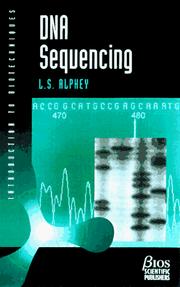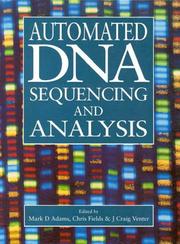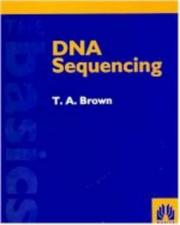| Listing 1 - 10 of 32 | << page >> |
Sort by
|
Book
ISBN: 0713126477 Year: 1977 Volume: 83
Abstract | Keywords | Export | Availability | Bookmark
 Loading...
Loading...Choose an application
- Reference Manager
- EndNote
- RefWorks (Direct export to RefWorks)

ISBN: 1859960618 0387915095 9780387915098 9781859960615 Year: 1997 Publisher: Oxford New York Bios Scientific Publishers Springer
Abstract | Keywords | Export | Availability | Bookmark
 Loading...
Loading...Choose an application
- Reference Manager
- EndNote
- RefWorks (Direct export to RefWorks)
Nucleotide sequence --- Bioinformatics --- Séquence nucléotidique --- Bio-informatique --- 577.212.3 --- Nucleic acid base and sequence compositon. Experimental deciphering of genetic code. --- Nucleotide sequence. --- 577.212.3 Nucleic acid base and sequence compositon. Experimental deciphering of genetic code. --- Séquence nucléotidique --- Sequence Analysis, DNA --- Molecular Biology --- methods

ISBN: 0127170103 0080926398 Year: 1994 Publisher: London Academic press
Abstract | Keywords | Export | Availability | Bookmark
 Loading...
Loading...Choose an application
- Reference Manager
- EndNote
- RefWorks (Direct export to RefWorks)
577.212.3 --- 57.088.5 --- Nucleic acid base and sequence compositon. Experimental deciphering of genetic code. --- Methods and techniques for studying structures and properties of biological molecules --- 577.212.3 Nucleic acid base and sequence compositon. Experimental deciphering of genetic code. --- DNA --- Nucleotide sequence --- Data processing.

ISBN: 0879696362 9780879696368 Year: 2003 Publisher: Cold Spring Harbor (N.Y.): Cold Spring Harbor Laboratory,
Abstract | Keywords | Export | Availability | Bookmark
 Loading...
Loading...Choose an application
- Reference Manager
- EndNote
- RefWorks (Direct export to RefWorks)
Molecular biology --- 577.212.3 --- 57.081 --- Nucleic acid base and sequence compositon. Experimental deciphering of genetic code. --- General organization of biological laboratories --- 57.081 General organization of biological laboratories --- 577.212.3 Nucleic acid base and sequence compositon. Experimental deciphering of genetic code. --- Molecular Biology --- Molecular biochemistry --- Molecular biophysics --- Biochemistry --- Biophysics --- Biomolecules --- Systems biology --- Nucleic acid base and sequence compositon. Experimental deciphering of genetic code
Book
ISBN: 3527318852 3527622551 9783527318858 9783527622559 Year: 2008 Publisher: Weinheim Wiley-VCH
Abstract | Keywords | Export | Availability | Bookmark
 Loading...
Loading...Choose an application
- Reference Manager
- EndNote
- RefWorks (Direct export to RefWorks)
Genome, Plant. --- Genomics --- Plant genetics. --- Plant genomes. --- Plants --- Methods. --- Genetics. --- Plant genetics --- Plant genomes --- 57.088 --- 577.212.3 --- Plant genome --- Genomes --- Genetics --- 577.212.3 Nucleic acid base and sequence compositon. Experimental deciphering of genetic code. --- Nucleic acid base and sequence compositon. Experimental deciphering of genetic code. --- 57.088 Special methods and techniques for studing biological molecules. Separation. Centrifuging. X-ray study. Radioisotope methods --- Special methods and techniques for studing biological molecules. Separation. Centrifuging. X-ray study. Radioisotope methods

ISBN: 0125215266 0121366553 9786611755072 1281755079 0080860559 9780125215268 Year: 1998 Volume: 26 Publisher: New York (N.Y.): Academic press,
Abstract | Keywords | Export | Availability | Bookmark
 Loading...
Loading...Choose an application
- Reference Manager
- EndNote
- RefWorks (Direct export to RefWorks)
582.282.232 --- 663.12 --- 575.113 --- 577.212 --- 57.083.1 --- Sacharomycetaceae --- Yeasts in general. Brewing yeast. Ascending and descending yeasts --- Gene. Genetic apparatus. Genome --- Central dogma of molecular biology. Coding of inheritance information. The genetic code and its chemical nature --- Microbiological methods and techniques --- 57.083.1 Microbiological methods and techniques --- 577.212 Central dogma of molecular biology. Coding of inheritance information. The genetic code and its chemical nature --- 575.113 Gene. Genetic apparatus. Genome --- 663.12 Yeasts in general. Brewing yeast. Ascending and descending yeasts --- 582.282.232 Sacharomycetaceae --- genomes --- nomenclature --- Yeasts --- chromosomes --- gene expression --- proteins --- Immunology --- Mutation --- mutation --- Nomenclature --- Yeast fungi --- Genetics --- mutation. --- nomenclature.

ISBN: 1859962734 Year: 2004 Publisher: New York (N.Y.) : BIOS scientific,
Abstract | Keywords | Export | Availability | Bookmark
 Loading...
Loading...Choose an application
- Reference Manager
- EndNote
- RefWorks (Direct export to RefWorks)
The Advanced Text series is designed for students taking advanced-level courses, including final year undergraduates and taught MSc. Marine microbiology is a rapidly expanding subject. New tools and an increased interest in ecological factors have caused an upsurge of interest in this field of study. This book aims to convey the fascinating discoveries and great importance of this fast-moving discipline to the student. Proteomics is a major new area of scientific research driven by the growing information gap between genes and their functions. Large-scale DNA sequencing and annotation projects identify thousands of new genes on a daily basis but the functions of these genes remain largely unknown. Proteins are the actual functional molecules of the cell, and technical advances in the high-throughput analysis of proteins now allow these molecules to be studied directly. Principles of Proteomics provides a comprehensive introduction to this relatively new field, for the first time bringing together all the disparate themes of proteomics. The book covers the development of large-scale technologies for protein separation, isolation, detection and quantitation. It describes in detail the role of mass spectrometry in high-throughput protein annotation. It also covers the emerging fields of structural proteomics, interaction proteomics and the recent development of chip-based analysis techniques. The final chapter provides some examples of how proteomics is being applied in the fields of medicine, biotechnology and agriculture.
Proteomics. --- 577.212.3 --- 577.112 --- 57.088 --- Nucleic acid base and sequence compositon. Experimental deciphering of genetic code. --- Proteins --- Special methods and techniques for studing biological molecules. Separation. Centrifuging. X-ray study. Radioisotope methods --- Aminozuursequenties --- Eiwitten --- Structuur --- Aminozuursequenties. --- Eiwitten. --- Structuur. --- 57.088 Special methods and techniques for studing biological molecules. Separation. Centrifuging. X-ray study. Radioisotope methods --- 577.112 Proteins --- 577.212.3 Nucleic acid base and sequence compositon. Experimental deciphering of genetic code. --- Proteomics --- Molecular biology --- Nucleic acid base and sequence compositon. Experimental deciphering of genetic code --- Moleculaire biologie.

ISBN: 9780199299188 Year: 2007 Publisher: Oxford Oxford university press
Abstract | Keywords | Export | Availability | Bookmark
 Loading...
Loading...Choose an application
- Reference Manager
- EndNote
- RefWorks (Direct export to RefWorks)
575.86 --- 577.212.3 --- 57.088.5 --- Origin of groups of organisms (taxa). Phylogeny --- Nucleic acid base and sequence compositon. Experimental deciphering of genetic code. --- Methods and techniques for studying structures and properties of biological molecules --- GEN Genetics & Population Genetics --- phylogeny --- evolution --- ancestral state --- mutations --- history --- 577.212.3 Nucleic acid base and sequence compositon. Experimental deciphering of genetic code. --- 575.86 Origin of groups of organisms (taxa). Phylogeny --- Evolutionary genetics --- Nucleotide sequence --- Analysis, Nucleic acid sequence --- Analysis, Nucleotide sequence --- Base sequence (Nucleic acids) --- DNA sequence --- Nucleic acid sequence analysis --- Nucleotide sequence analysis --- RNA sequence --- Sequence, Nucleotide --- Nucleic acids --- Nucleotides --- Sequence alignment (Bioinformatics) --- Genetic evolution --- Evolution (Biology) --- Genetics --- Analysis

ISBN: 0896032469 0896032760 159259512X 1592595111 Year: 1994 Volume: 24, 25 Publisher: Totowa, N.J. : Humana Press,
Abstract | Keywords | Export | Availability | Bookmark
 Loading...
Loading...Choose an application
- Reference Manager
- EndNote
- RefWorks (Direct export to RefWorks)
DNA sequencing has become increasingly efficient over the years, resulting in an enormous increase in the amount of data gen- ated. In recent years, the focus of sequencing has shifted, from being the endpoint of a project, to being a starting point. This is especially true for such major initiatives as the human genome project, where vast tracts of DNA of unknown function are sequenced. This sheer volume of available data makes advanced computer methods ess- tial to analysis, and a familiarity with computers and sequence ana- sis software a vital requirement for the researcher involved with DNA sequencing. Even for nonsequencers, a familiarity with sequence analysis software can be important. For instance, gene sequences already present in the databases can be extremely useful in the design of cloning and genetic manipulation experiments. This two-part work on Analysis of Data is designed to be a practical aid to the researcher who uses computers for the acquisition, storage, or analysis of nucleic acid (and/or p- tein) sequences. Each chapter is written such that a competent sci- tist with basic computer literacy can carry out the procedure successfully at the first attempt by simply following the detailed pr- tical instructions that have been described by the author. A Notes section, which is included at the end of each chapter, provides advice on overcoming the common problems and pitfalls sometimes enco- tered by users of the sequence analysis software. Software packages for both the mainframe and personal computers are described.
Amino acid sequence --- Nucleotide sequence --- Data processing. --- 577.212.3 --- 57.088.5 --- 57.081.2 --- 57.081.2 Automation of biological experiments --- Automation of biological experiments --- 577.212.3 Nucleic acid base and sequence compositon. Experimental deciphering of genetic code. --- Nucleic acid base and sequence compositon. Experimental deciphering of genetic code. --- Methods and techniques for studying structures and properties of biological molecules --- Séquence des acides aminés --- Séquence nucléotidique --- Data processing --- Informatique --- Amino acid sequence analysis --- Analysis, Amino acid sequence --- Peptide sequence --- Peptide sequencing --- Protein sequence --- Protein sequencing --- Sequence, Amino acid --- Amino acids --- Proteins --- Sequence alignment (Bioinformatics) --- Analysis --- Cytology. --- Cell Biology. --- Cell biology --- Cellular biology --- Biology --- Cells --- Cytologists

ISBN: 0199634211 9780199634217 Year: 1994 Publisher: Oxford: IRL press,
Abstract | Keywords | Export | Availability | Bookmark
 Loading...
Loading...Choose an application
- Reference Manager
- EndNote
- RefWorks (Direct export to RefWorks)
Nucleotide sequence --- 577.323 --- 577.212.3 --- 577.212.3 Nucleic acid base and sequence compositon. Experimental deciphering of genetic code. --- Nucleic acid base and sequence compositon. Experimental deciphering of genetic code. --- 577.323 Physics and physical chemistry of nucleic acids --- Physics and physical chemistry of nucleic acids --- Analysis, Nucleic acid sequence --- Analysis, Nucleotide sequence --- Base sequence (Nucleic acids) --- DNA sequence --- Nucleic acid sequence analysis --- Nucleotide sequence analysis --- RNA sequence --- Sequence, Nucleotide --- Nucleic acids --- Nucleotides --- Sequence alignment (Bioinformatics) --- Analysis --- Sequence Analysis, DNA --- Nucleotide sequence. --- Séquence nucléotidique --- methods.
| Listing 1 - 10 of 32 | << page >> |
Sort by
|

 Search
Search Feedback
Feedback About UniCat
About UniCat  Help
Help News
News